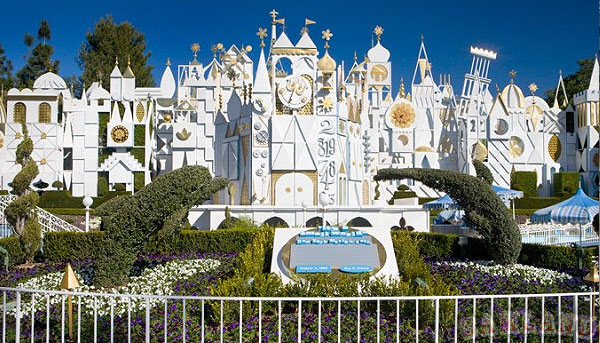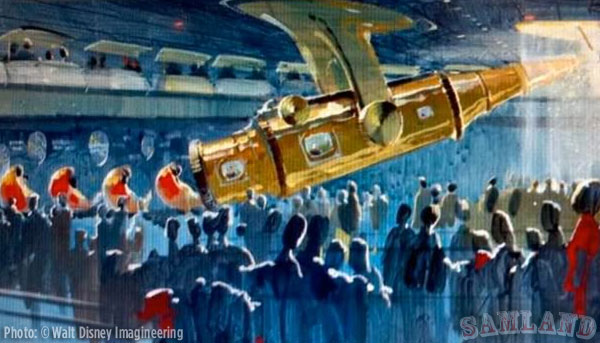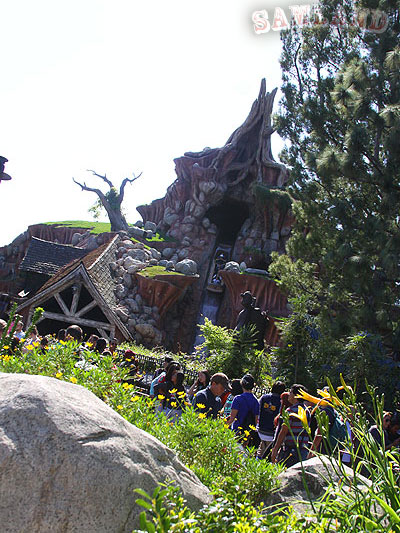The sponge
A theme park is a sponge that sucks up people. It is a finite space that has an infinite capacity as long as there is someplace to put all the guests. If Disneyland were an empty lot you could theoretically put more than a 1.1 million people inside of the 85 or so acres. That gives each person 4 square feet, the rule that Disney uses.
But an empty lot does not attract people very often and the number of people able to fit within the space is greatly reduced once you start building the necessary infrastructure such as paths, offices, landscaping, etc. To make up for this short fall, a theme park can pack thousands of people inside of attractions, shows, queues, shops, and restaurants.
If you get the formula right you can do what Disneyland did on August 16, 1969 when 82,516 visited the park.
Today, the formula is not right. I argue that the overcrowding at the park has many factors, but the primary one is the theoretical Disneyland capacity has been cut by more than a third since 1977. There are just not enough seats for all those butts. Today, the park is allowed to be more crowded than it really needs to be.
Attendance has grown over the years. In 1977, 10.3 million visitors walked through the front gate. In 2013, there were more than 16.2 million. A significant contributor to that growth has been the Annual Passholder program, which allows for more frequent visits. I would guess that if you limited APs to a couple of visits a year and I would argue that attendance growth has been far less than 6 million unique individuals.
So what is the formula? Give people something to do. Give them someplace to stand or sit. Give them a reason to step out of the walkways and to go someplace so somebody else can take their spot on the walkway. This was the secret formula that was understood by earlier Imagineers. Now some will blame the addition of Fast Pass or parking or annual passholder or whatever. I suggest that it is because management and the Imagineers rarely stand in line. When one gets whisked backstage you tend to miss some things.
I decided to pick 2 years to compare – 1977 and current conditions. I selected 1977 because that is when I graduated from high school. Here are some examples of how things have changed. If you like to hear more examples just let me know in the comments.
Main Street

Disneyland Railroad
When Disneyland was first conceived, Walt hoped that your first ride would be on the Santa Fe and Disneyland Railroad. Taking a grand circle tour would orient you and highlight the major attractions. It would act like a movie trailer and give a hint of what is to come. Back in 1977 there were four authentic steam powered locomotives and three stations (Main Street, New Orleans Square/Frontierland, and Tomorrowland). Today there are four including Toontown/Fantasyland. The trains were always a people eater and remains so today. Over the years, expectations have not changed much. The old target was 2,149 guests and today it has been raised to 2,200.
Main Street Vehicles
Another way to entertain guests is the vehicles on Main Street. Like the trains, the capacity generated by the Omnibus, horseless carriages, and the fire engine have remained relatively the same (1977: 804 persons per hour – Today: 760 persons per hour). What did get trimmed was the burden carried by those brave horses of the streetcars. Back in the day management was counting on 1,186 people to ride the rails while today they only expect 360 people per hour.
Adventureland
Indiana Jones and the Temple of Doom

The last real E-Ticket built at Disneyland was Indiana Jones in 1995 (we’ll forget about Rocket Rods). Yep, twenty years ago. Now they have added a whole other theme park and upgraded older E-Ticket attractions during this time but it has been awhile inside of the Disneyland berm. When Mara is being kind, up to 1,800 guests an hours can enjoy the journey. What was remarkable about the attraction when it first opened was the queue. At almost a quarter of a mile, it could hold thousands. Today, much of that crowd is standing out front, due to Fastpass, and all that wonderful designed covered space within the caverns is lost to guests zooming through.
Frontierland
Big Thunder Mountain Railroad versus Mine Train Through Nature’s Wonderland
Big Thunder Mountain Railroad was added in 1979. The wonderfully designed, immersive attraction replaced the Mine Train Through Nature’s Wonderland. This is the rare case of the replacement adding capacity. The Mine Train was capable of 1,100 riders per hour while the roller coaster doubled that number to 2,200.
Fantasyland
It’s a small world

Since it’s a small world was built for a World’s Fair, it was purposely designed to be a people eater. Attendance at a theme park is just a pittance compared to the crowds who attend World’s Fairs. So Walt and the team decided to use boats to ferry people through the attraction. The result was so positive that Walt decided then and there to change the Pirates attraction from a walk-through to a boat ride. Although the original design capacity was a staggering 4,500 people per hour, the park was happy with 3,200 back in 1977. Today, with new slimmer boats and operating procedures that benefit guests with mobility concerns, that number has been reduced sharply to 1,925 guests per hour.
Matterhorn Bobsleds
When the tandem bobsleds appeared in 1978, the Matterhorn had increased its capacity by 70%. When things are running smoothly, more than 1850 guests per hour can slip down the icy slopes of Walt’s mountain. With the newest bobsleds comes a new seating configuration that has lowered that number to only 1,500 people per hour.
Tomorrowland
Space Mountain
Space Mountain opened in 1977. I remember vividly the line running from the attraction to the Main Street Station at my Grad night. I decided to do other things. Back in the day the Cast Members tried to load as many as 1,728 guests per hour on the roller coaster. The switchback queue allowed for 2,400 people to enjoy air-conditioning while waiting. Today, the throughput has been reduced slightly to 1,565 guests per hour. However, the queue has been reduced to a quick walk most of the time while guests now stand outside to wait their turn, again due to Fastpass.
Adventures Through Inner Space versus Star Tours

The almost psychedelic ride known as Adventures Through Inner Space was the first use of the Omnimover vehicle. This brilliant idea from Bob Gurr allowed the Imagineers to manipulate the rider just like a director could move a camera. It also allowed for huge numbers of people to enjoy an attraction. More than 2,000 people an hour could be shrunk down to the size of a water molecule (a hidden Mickey?). Toss in another 2,800 people in the winding queues and that adds up. Today that space contains Star Tours. With multiple Starspeeders, the Cast Members aim for 1,300 people per hour. Due to Fastpass, the queue in the show building has been reduced but Disneyland did carve out an extended queue into the former exit area of Inner Space.
America Sings versus Innoventions aka Marvel Meet and Greet Land
From the mighty Carousel of Progress to what is there today. Hmmm. Back to the numbers. Like small world, the Carousel Theater was designed to handle mind-numbing numbers of people. The robotic cast entertained more than 40,000 people a day. Back at Disneyland it was not different. By the time America Sings debuted the expectations had been lowered to 3,465 people per hour. The ride could be slammed and it was still a walk on. Sadly, that is one of the reasons why the robotic cast was booted over to Splash Mountain. Today, it is the Marvel meet and greets that drive attendance and that can suck up as many as 900 people per hour.
WEDway PeopleMover versus…an empty track?

The WEDway PeopleMover was the ultimate people eater. Theoretically, Cast Members could shove as many as 4,880 people on this ride but nobody ever expected to reach that number. Instead, the goal was to aim for a mere 3,000 people per hour. Today, well. That empty track doesn’t do much, does it?
Circlevision Theater versus Buzz Lightyear
As anyone who has visited Epcot at Walt Disney World can testify, Circlevision films can pack in a lot of people. In the case of Disneyland, America the Beautiful could be enjoyed by as many as 3,000 people per hour. Fortunately, Buzz Lightyear is an Omnimover attraction, which is capable of some pretty impressive numbers. In this case, 1,700 trainees can shoot it out per hour. That’s a lot, but not much more than half of the previous capacity.
New Orleans Square
Pirates of the Caribbean and the Haunted Mansion
These two crowd favorites have remained pretty consistent over the years. Pirates has entertained a remarkable 2,800 guests per hour while the Haunted Mansion adds another 2,100 happy guests. Both expectations are slightly down from 1977 but not by much.
Bear/Critter Country
Country Bear Jamboree versus Splash Mountain and Winnie the Pooh

Okay, I just had to chuckle at the above title. Never thought I would write that sentence before. When the Country Bear Jamboree opened, Disneyland built two theaters. The idea was the one in Florida was such a hit and had such long lines that they would double down and built a people eater capable of entertaining almost 1,900 people per hour. Splash Mountain is able to handle that many people and the addition of Winnie the Pooh tacks on an additional 950 or so people. So that’s a net gain for the new guys.
Mickey’s Toontown
Roger Rabbit and Friends
Mickey’s Toontown opened in 1993 as a reliable spot to find your favorite character. It also added a few acres of real estate to Disneyland by burrowing under the northern berm and landing against a parking structure backstage. As a result, guests can enjoy the food court, walking through Minnie and Mickey’s houses, Donald’s boat, and let the toddlers free at Goofy’s house. The two attractions (Roger Rabbit and Gadget’s coaster) suck up 640 and 525 people per hour respectively. Of course, the Roger Rabbit queues is long, incredible, and can handle quite the crowd.
Overall, we see that Disneyland capacity has been losing ground, but attendance continues to increase at the same time. Has the commitment to guests diminished? Are newer ride systems simply incapable of high capacity? Or has Disney forgotten the lessons learned by the first batch of Imagineers? Our best comments always come from you, our amazing readers. What are your thoughts?
Sam is the author of several popular theme park books:
Follow Sam’s page on Facebook:
(Please keep your comments family friendly and avoid attacking other commenters or our staff. Hostility and off topic comments will be removed.)


You must be logged in to post a comment.